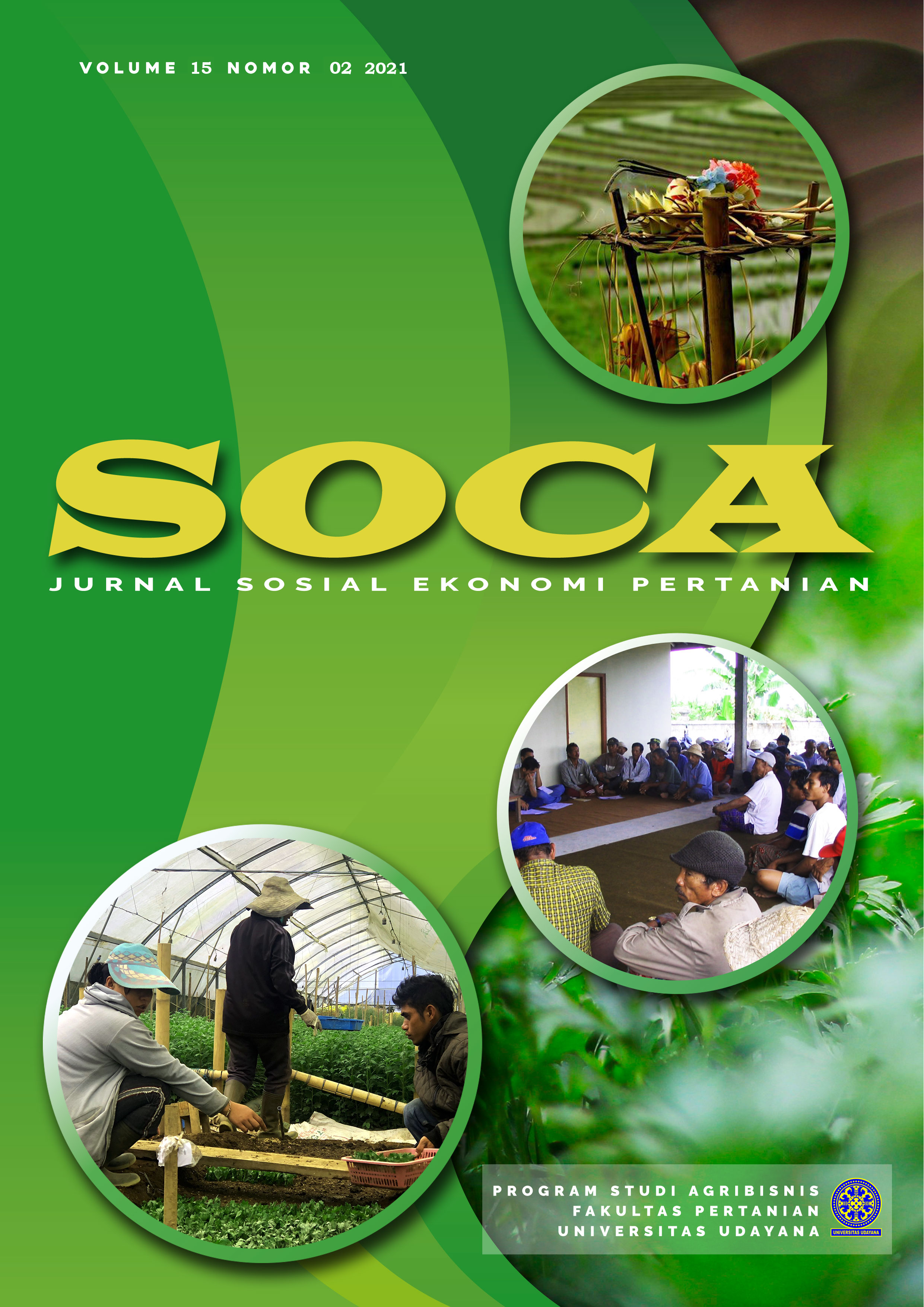The Effectiveness of Fertilizer Subsidy: How the Impact to the Production
Abstract
A lot of budgets had spent by the government on fertilizer subsidies. However, in its implementation there were still many obstacles. Therefore, the effectiveness of subsidies and their impact on production was interesting to study. The aim of this research was to describe the effectiveness of fertilizer subsidies and to determine the impact of the effectiveness of fertilizer subsidies on rice production. This research was conducted in Sukaasih Village, Sukatani Sub-district, Bekasi Regency. The research sample was determined by the multistage sampling method which resulted 109 farmers samples. The data that had been obtained were analyzed using frequency distribution analysis and multiple linear regression. The results showed that the implementation of fertilizer subsidies in Sukaasih Village was not effective. Variables that affected rice production were land area, the use of NPK fertilizer, SP-36, the use of seeds, and the effectiveness of fertilizer subsidies. Therefore, the government needs to tighten the target and application of subsidized fertilizers by collaborating with related parties so that subsidized fertilizers can be effective, on target, and efficient because the effectiveness of subsidized fertilizers affected rice production.
Downloads
References
Arisandi, N. W. (2016). Efektivitas Distribusi Subsidi Pupuk Organik dan Dampaknya terhadap Pendapatan Usahatani Padi Sawah di Subak Sungsang, Desa Tibubiu, Kabupaten Tabanan. Jurnal Agribisnis dan Agrowisata 5(1), 1-10.
Asian Development Bank. (2019). Polices to Support Invesment Requirements of Indonesia's Food and Agriculture Development During 2020-2045. Manila: Asian Development Bank.
Azumah, S. B., & Zakaria, A. (2019). Fertilizer Subsidy and Rice Productivity in Ghana: A Microeconomic Study. Journal of Agricultural Studies, 7(1), 82-102.
Badan Kebijakan Fiskal. (2017). Seri Analisis Kebijakan Fiskal: Dinamika Kebijakan Subsidi Pupuk dan Ketahanan Pangan. Jakarta: PT Gramedia Pustaka Utama.
Badan Pusat Statistik Jawa Barat. (2020). Provinsi Jawa Barat dalam Angka 2020. Bandung: Badan Pusat Statistik Provinsi Jawa Barat.
Darwis, V., & Supriyati. (2013). Subsidi Pupuk: Kebijakan, Pelaksanaan, dan Optimalisasi Pemanfaatannya. Analisis Kebijakan Pertanian, 11(1), 45-60.
Dembele, D., Ballo, M., Ballo, A., & Ba, B. d. (2019). Impact of Fertilizer Usage on Crop Productivity at Siguidolo. International Journal of Environment, Agriculture and Biotechnology (IJEAB), 4(5), 1559-1566.
Dharmveer. (2015). Fertilizer Subsidy in India. International Research Journal of Management Sociology and Humanity, 6(12), 98-106.
Fearon, J., Adraki, P. K., & Boateng, V. F. (2015). Fertilizer Subsidy Programme in Ghana: Evidence and Performance after Six Years of Implementation. Journal of Biology, Agriculture, and Healthcare, 5, 100-107.
Gulati, A., & Banerjee, P. (2015). Rasionalising Fertiliser Subsidy in India: Key Issues and Policy Option. New Delhi: Indian Council for Research on International Economic Relations.
Haque, A. H., Elazegui, F. A., Mia, M. A., Kamal, M. M., & Haque, M. M. (2012). Increase in Rice Yeild Through the Use of Quality Seeds in Bangladesh. African Journal of Agricultural Research, 7(26), 3819-3827.
Hariningtyas, F. C. (2014). Pengaruh Efektivitas Subsidi Pupuk terhadap Produksi Padi di Kabupaten Kendal. [Skripsi]. Surakarta: Fakultas Pertanian Universitas Sebelas Maret Surakarta.
Hartatik, W., Husnain, & Widowati, L. R. (2015). Peranan Pupuk Organik dalam Peningkatan Produktivitas Tanah dan Tanaman. Jurnal Sumber Daya Lahan, 9(2), 107-120.
Holden, S., & Lunduka, R. (2010). Impacts of the Fertilizer Subsidy Programme in Malawi: Targeting, Household Perceptions and Preferences . Norway: Department of International Environment and Development Studies, Norwegian University of Life Sciences.
Jorgi, R. S., Gayatri, S., & Dalmiyatun, T. (2019). Hubungan Tingkat Pengetahuan Petani dengan Efektivitas Pelaksanaan Program Kartu Tani di Kabupaten Semarang. AGRARIS: Journal of Agribusiness and Rural Development Research 5(2), 88-98.
Kariyasa, I. K., & Yusdja, Y. (2005). Evaluasi Kebijakan Sistem Distribusi Pupuk Urea di Indonesia: Kasus Provinsi Jawa Barat. Analisis Kebijakan Pertanian, 3(3), 201-216.
Kementerian Keuangan RI. (2020). Alokasi Anggaran Kedaulatan Pangan. Diambil kembali dari Portal Data APBN Kementerian Keuangan RI: http://www.data-apbn.kemenkeu.go.id/Dataset/Details/1015
Kementerian Pertanian RI. (2019). Data Lima Tahun Terakhir Subsektor Tanaman Pangan. Diambil kembali dari Website Kementerian Pertanian: pertanian.go.id/Data5tahun/TPATAP-2017(pdf)/20-ProdPadi.pdf
Kementerian Pertanian RI. (2020). Petunjuk Teknis Pelaksanaan Penyediaan dan Penyaluran Pupuk Bersubsidi TA 2020 (Revisi). Jakarta: Direktorat Jenderal Prasarana dan Sarana Pertanian Kementerian Pertanian.
Kostov, P., Davidova, S., & Bailey, A. S. (2018). Effect on Family Labour on Output of Farms in Selected EU Member States: A Non-parametric Quantile Regression Approach. European Review of Agricultural Economics, 45(3), 1-39.
Kusuma, F. C. (2018). Pengaruh Pemberian Beberapa Sumber Pupuk padaPertumbuhan dan Hasil Beberapa Varietas Padi (Oryza sativa L.) di Desa Tembalang Kecamatan Wlingi. Jurnal Produksi Tanaman 6(2), 223-229.
Marisa, S. (2011). Analisis Efektivitas Kebijakan Subsidi Pupuk dan Pengaruhnya terhadap Produksi Padi (Studi Kasus: Kabupaten Bogor). [Skripsi]. Bogor: Fakultas Ekonomi dan Manajemen Institut Pertanian Bogor.
Mustapha, S., Abdulai, I. A., & Urtarz, Y. (2016). Evaluating the Determinants of Access to Ghana Fertilizer Subsidy Program. Asian Journal of Agricultural Extension, Economics & Sociology, 11(3), 1-11.
Rizieq, R. (2010). Dampak Subsidi Pupuk terhadap Kesejahteraan Petani. SOCA: Jurnal Sosial Ekonomi Pertanian, 10(2), 121-133.
Stephenson, R. C., Coker, C. E., Posadas, B. C., Bachman, G. R., Harkess, R. L., Adamczyk, J. J., & Knight, P. R. (2020). Economic Effect on Insect Pest Management Strategies on Small-scale Tomato Production in Mississippi. HortTechnology, 30(1), 64-75.
Susila, W. R. (2010). Kebijakan Subsidi Pupuk: Perlu Ditinjau Kembali. Jurnal Litbang Pertanian 29(2), 43-49.
Tarimo, B., Mtalo, E., & Liwa, E. (2013). Land Use Change Detection and Impact Assessment on an Agricultural Area. Journal of Sustainable Development, 6(11), 55-70.













